Educating Clinical Staff and HIV/AIDS Practice Change Simulation
VerifiedAdded on 2022/11/11
|16
|1564
|280
Project
AI Summary
This project details a strategic plan aimed at reducing HIV/AIDS infections and transmission through educating clinical staff and implementing practice changes. The plan utilizes an evidence-based practice (EBP) model to identify the causes of increased infections and develop effective interventions. It outlines objectives such as educating healthcare workers on HIV management, reducing stigmatization, and utilizing proper dissemination methods. The project also explores the ACE star model of knowledge transformation, potential barriers to implementation (including opposition, financial constraints, and illiteracy), and strategies to overcome these barriers. It further discusses methods for evaluating the practice change's effectiveness, ethical considerations, and the importance of administrative support and stakeholder engagement. The project emphasizes the use of internal evidence to demonstrate improved outcomes and the need to address ethical concerns related to patient rights and healthcare worker interests. References to relevant literature are included to support the plan's framework and proposed strategies.
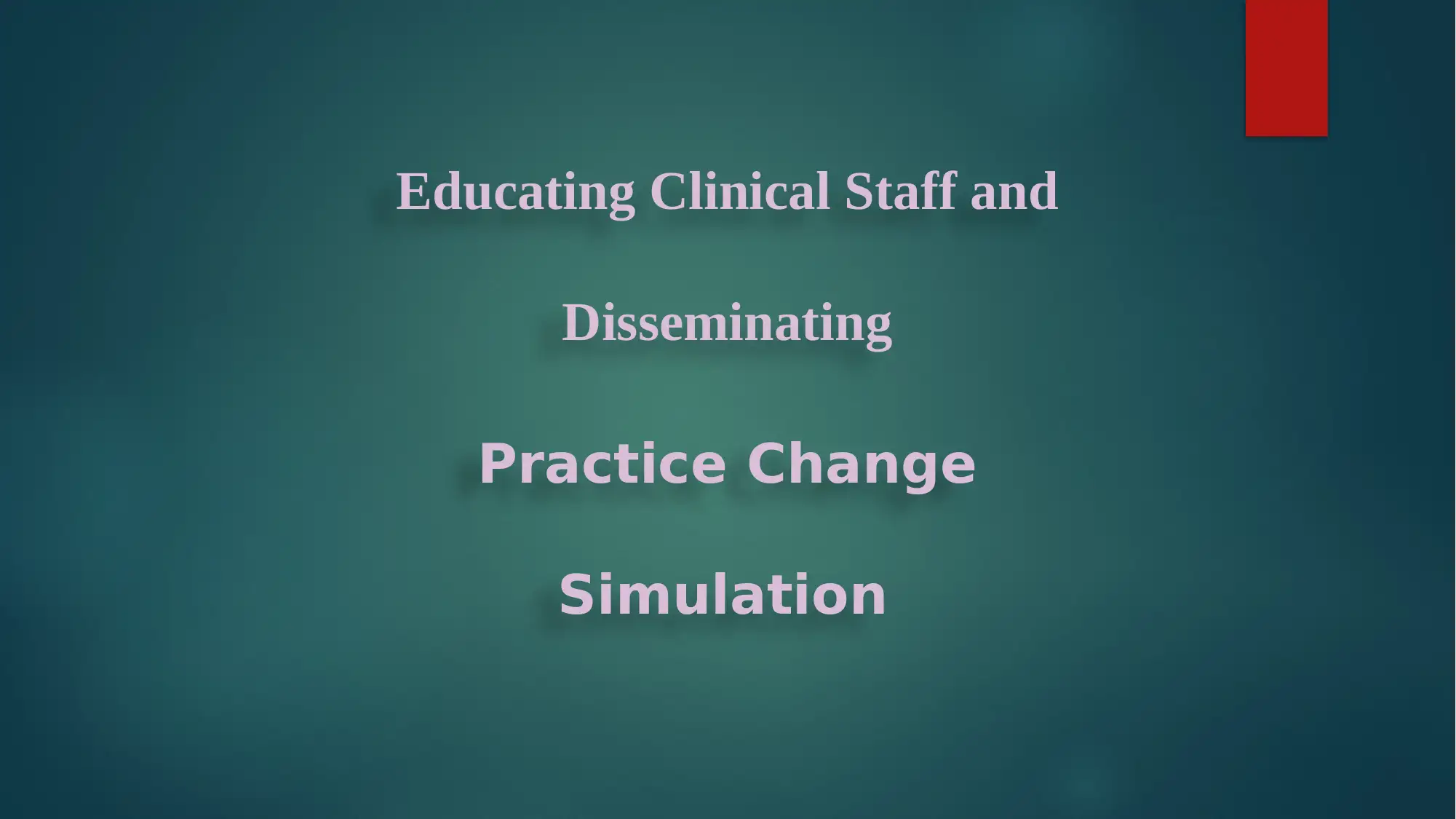
Educating Clinical Staff and
Disseminating
Practice Change
Simulation
Disseminating
Practice Change
Simulation
Paraphrase This Document
Need a fresh take? Get an instant paraphrase of this document with our AI Paraphraser
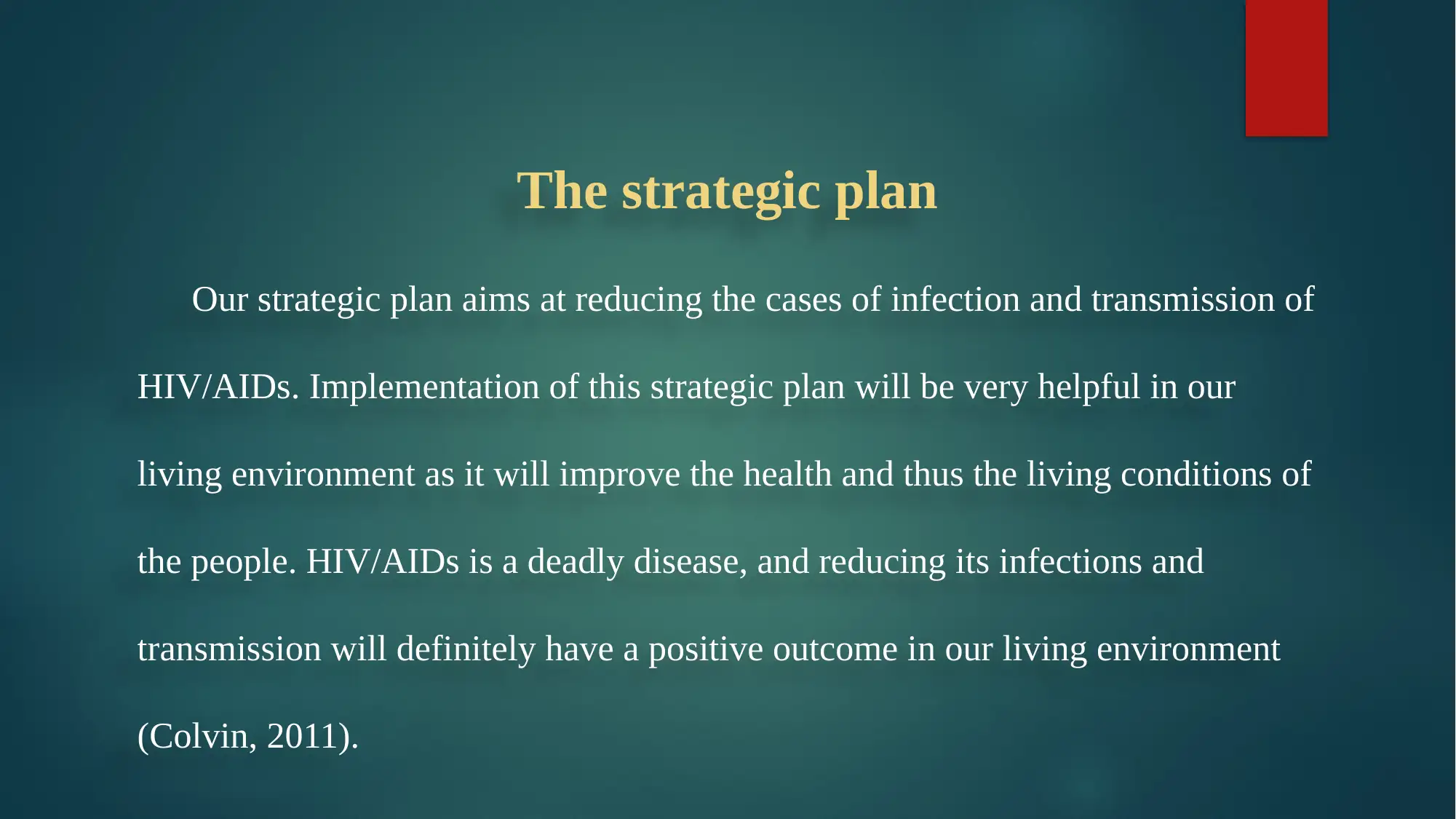
The strategic plan
Our strategic plan aims at reducing the cases of infection and transmission of
HIV/AIDs. Implementation of this strategic plan will be very helpful in our
living environment as it will improve the health and thus the living conditions of
the people. HIV/AIDs is a deadly disease, and reducing its infections and
transmission will definitely have a positive outcome in our living environment
(Colvin, 2011).
Our strategic plan aims at reducing the cases of infection and transmission of
HIV/AIDs. Implementation of this strategic plan will be very helpful in our
living environment as it will improve the health and thus the living conditions of
the people. HIV/AIDs is a deadly disease, and reducing its infections and
transmission will definitely have a positive outcome in our living environment
(Colvin, 2011).
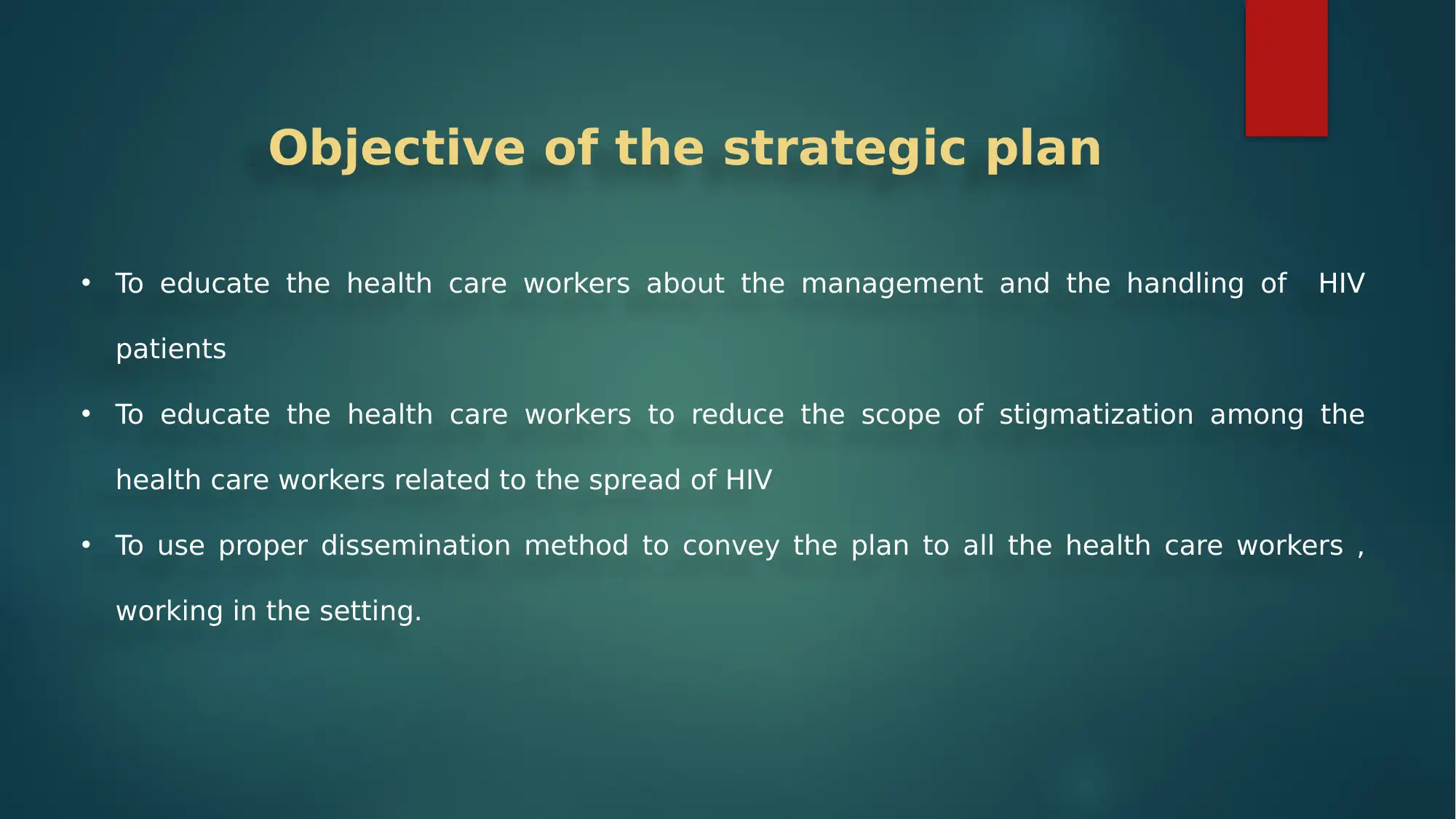
Objective of the strategic plan
• To educate the health care workers about the management and the handling of HIV
patients
• To educate the health care workers to reduce the scope of stigmatization among the
health care workers related to the spread of HIV
• To use proper dissemination method to convey the plan to all the health care workers ,
working in the setting.
• To educate the health care workers about the management and the handling of HIV
patients
• To educate the health care workers to reduce the scope of stigmatization among the
health care workers related to the spread of HIV
• To use proper dissemination method to convey the plan to all the health care workers ,
working in the setting.
⊘ This is a preview!⊘
Do you want full access?
Subscribe today to unlock all pages.

Trusted by 1+ million students worldwide
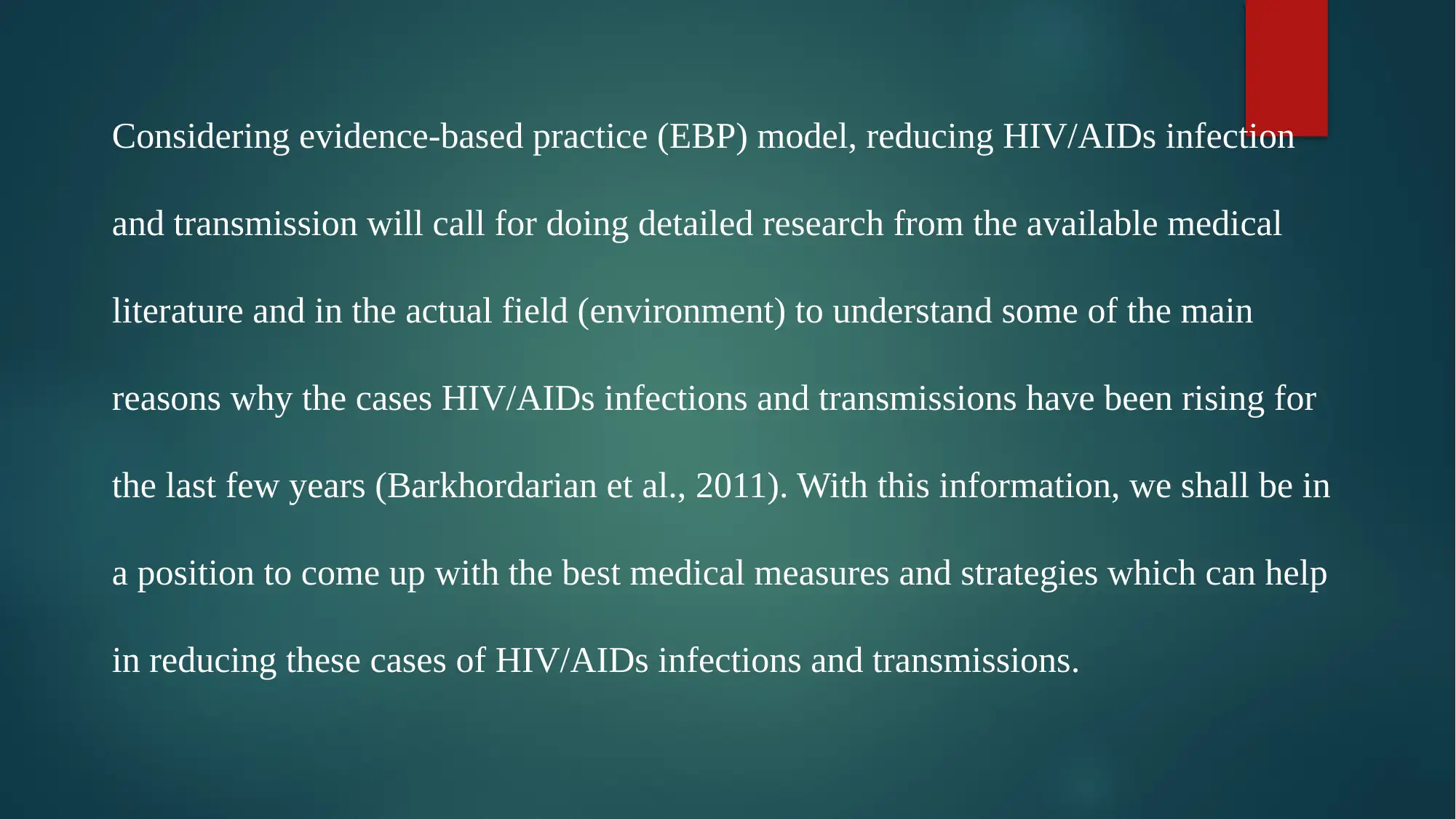
Considering evidence-based practice (EBP) model, reducing HIV/AIDs infection
and transmission will call for doing detailed research from the available medical
literature and in the actual field (environment) to understand some of the main
reasons why the cases HIV/AIDs infections and transmissions have been rising for
the last few years (Barkhordarian et al., 2011). With this information, we shall be in
a position to come up with the best medical measures and strategies which can help
in reducing these cases of HIV/AIDs infections and transmissions.
and transmission will call for doing detailed research from the available medical
literature and in the actual field (environment) to understand some of the main
reasons why the cases HIV/AIDs infections and transmissions have been rising for
the last few years (Barkhordarian et al., 2011). With this information, we shall be in
a position to come up with the best medical measures and strategies which can help
in reducing these cases of HIV/AIDs infections and transmissions.
Paraphrase This Document
Need a fresh take? Get an instant paraphrase of this document with our AI Paraphraser
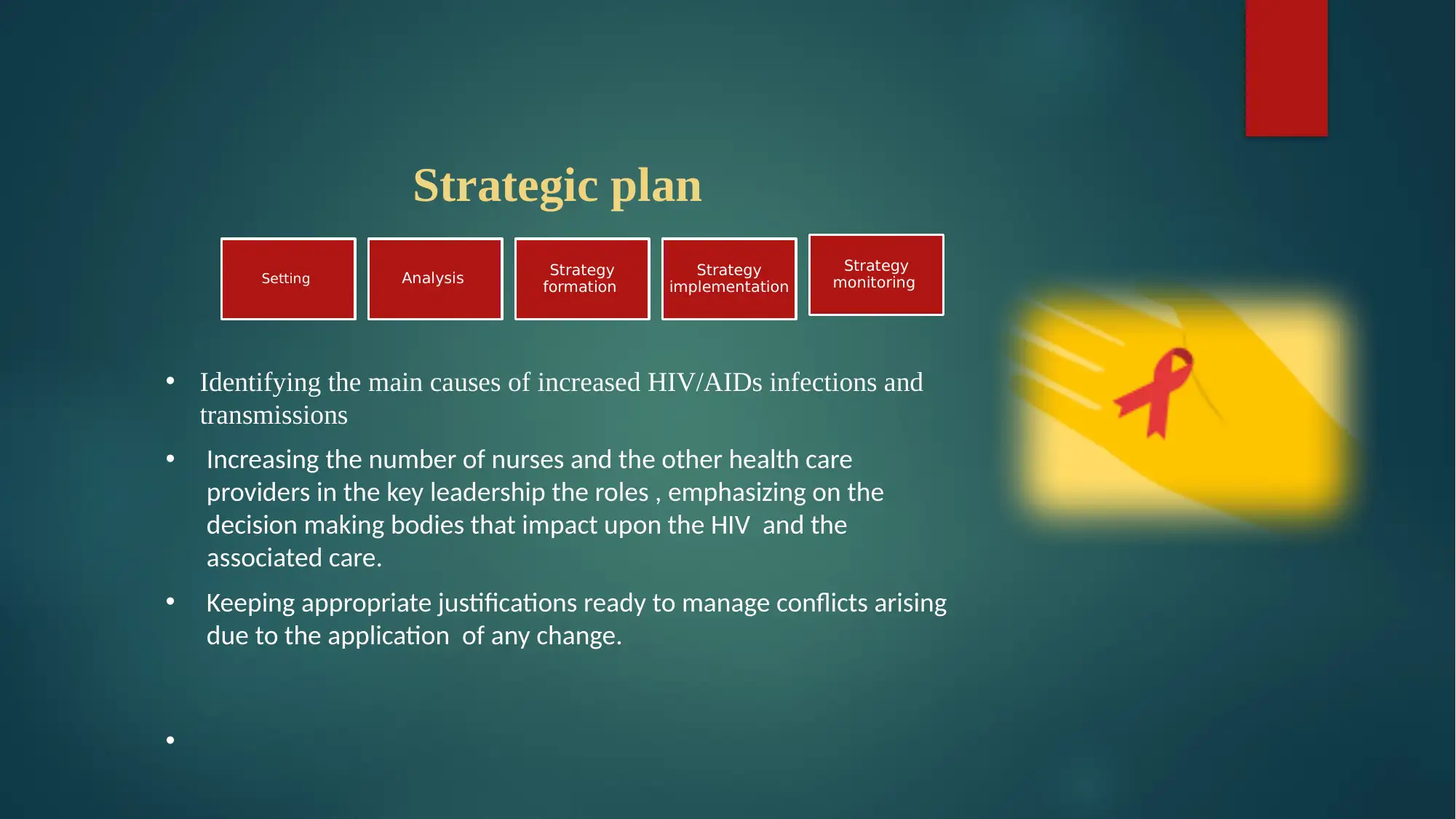
Strategic plan
• Identifying the main causes of increased HIV/AIDs infections and
transmissions
• Increasing the number of nurses and the other health care
providers in the key leadership the roles , emphasizing on the
decision making bodies that impact upon the HIV and the
associated care.
• Keeping appropriate justifications ready to manage conflicts arising
due to the application of any change.
•
Setting Analysis Strategy
formation
Strategy
implementation
Strategy
monitoring
• Identifying the main causes of increased HIV/AIDs infections and
transmissions
• Increasing the number of nurses and the other health care
providers in the key leadership the roles , emphasizing on the
decision making bodies that impact upon the HIV and the
associated care.
• Keeping appropriate justifications ready to manage conflicts arising
due to the application of any change.
•
Setting Analysis Strategy
formation
Strategy
implementation
Strategy
monitoring
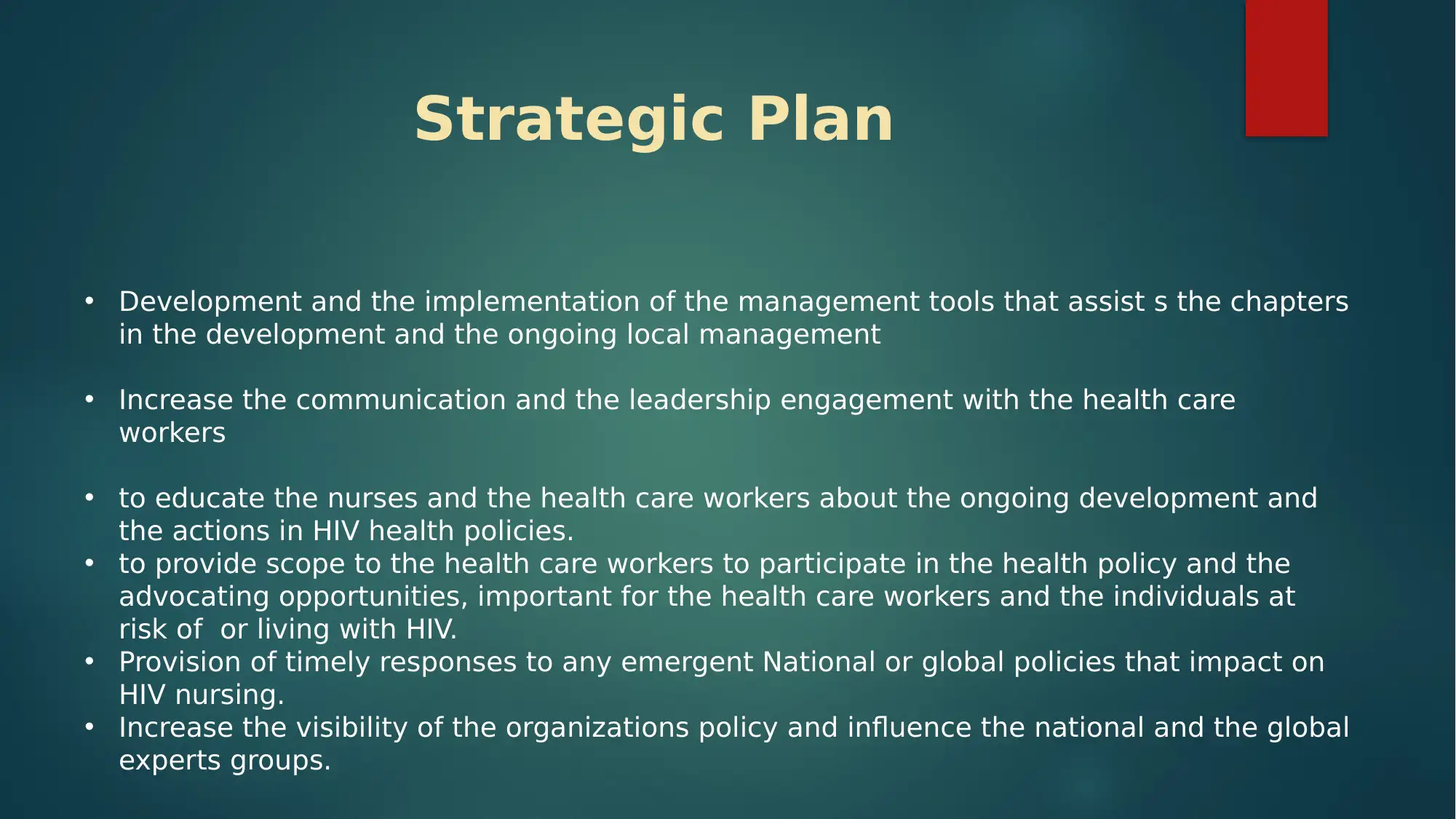
• Development and the implementation of the management tools that assist s the chapters
in the development and the ongoing local management
• Increase the communication and the leadership engagement with the health care
workers
• to educate the nurses and the health care workers about the ongoing development and
the actions in HIV health policies.
• to provide scope to the health care workers to participate in the health policy and the
advocating opportunities, important for the health care workers and the individuals at
risk of or living with HIV.
• Provision of timely responses to any emergent National or global policies that impact on
HIV nursing.
• Increase the visibility of the organizations policy and influence the national and the global
experts groups.
Strategic Plan
in the development and the ongoing local management
• Increase the communication and the leadership engagement with the health care
workers
• to educate the nurses and the health care workers about the ongoing development and
the actions in HIV health policies.
• to provide scope to the health care workers to participate in the health policy and the
advocating opportunities, important for the health care workers and the individuals at
risk of or living with HIV.
• Provision of timely responses to any emergent National or global policies that impact on
HIV nursing.
• Increase the visibility of the organizations policy and influence the national and the global
experts groups.
Strategic Plan
⊘ This is a preview!⊘
Do you want full access?
Subscribe today to unlock all pages.

Trusted by 1+ million students worldwide
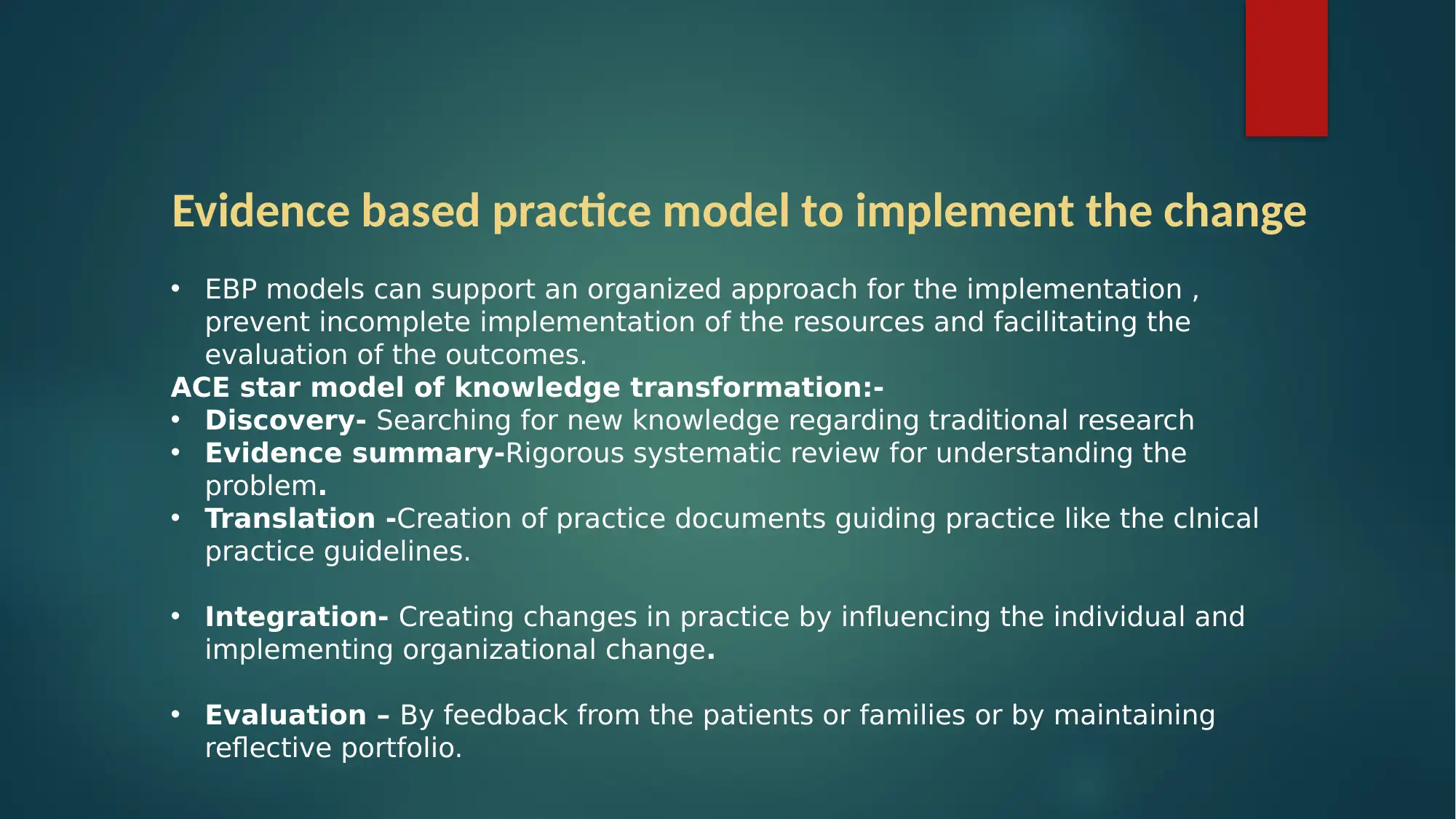
Evidence based practice model to implement the change
• EBP models can support an organized approach for the implementation ,
prevent incomplete implementation of the resources and facilitating the
evaluation of the outcomes.
ACE star model of knowledge transformation:-
• Discovery- Searching for new knowledge regarding traditional research
• Evidence summary-Rigorous systematic review for understanding the
problem.
• Translation -Creation of practice documents guiding practice like the clnical
practice guidelines.
• Integration- Creating changes in practice by influencing the individual and
implementing organizational change.
• Evaluation – By feedback from the patients or families or by maintaining
reflective portfolio.
• EBP models can support an organized approach for the implementation ,
prevent incomplete implementation of the resources and facilitating the
evaluation of the outcomes.
ACE star model of knowledge transformation:-
• Discovery- Searching for new knowledge regarding traditional research
• Evidence summary-Rigorous systematic review for understanding the
problem.
• Translation -Creation of practice documents guiding practice like the clnical
practice guidelines.
• Integration- Creating changes in practice by influencing the individual and
implementing organizational change.
• Evaluation – By feedback from the patients or families or by maintaining
reflective portfolio.
Paraphrase This Document
Need a fresh take? Get an instant paraphrase of this document with our AI Paraphraser
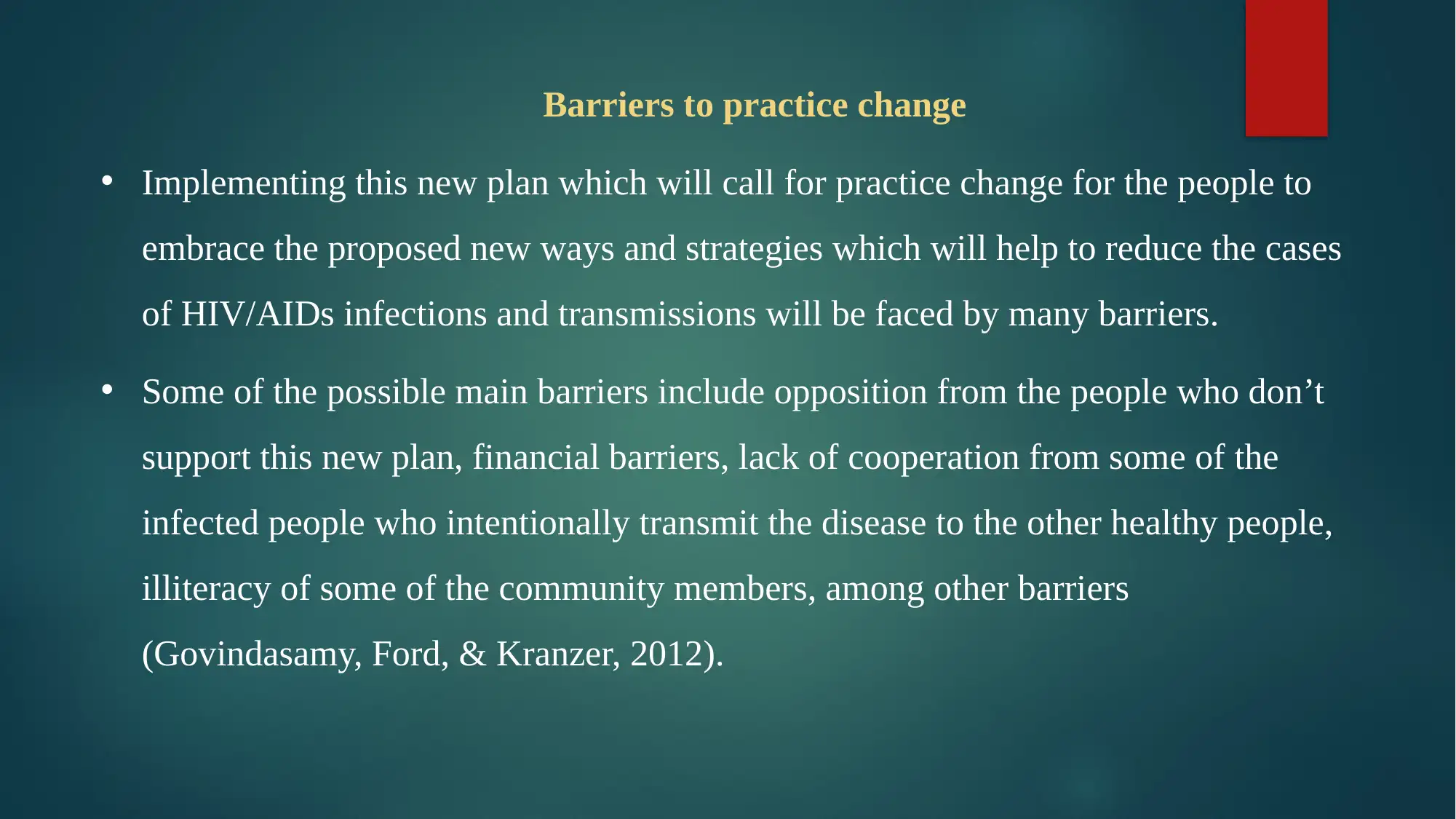
Barriers to practice change
• Implementing this new plan which will call for practice change for the people to
embrace the proposed new ways and strategies which will help to reduce the cases
of HIV/AIDs infections and transmissions will be faced by many barriers.
• Some of the possible main barriers include opposition from the people who don’t
support this new plan, financial barriers, lack of cooperation from some of the
infected people who intentionally transmit the disease to the other healthy people,
illiteracy of some of the community members, among other barriers
(Govindasamy, Ford, & Kranzer, 2012).
• Implementing this new plan which will call for practice change for the people to
embrace the proposed new ways and strategies which will help to reduce the cases
of HIV/AIDs infections and transmissions will be faced by many barriers.
• Some of the possible main barriers include opposition from the people who don’t
support this new plan, financial barriers, lack of cooperation from some of the
infected people who intentionally transmit the disease to the other healthy people,
illiteracy of some of the community members, among other barriers
(Govindasamy, Ford, & Kranzer, 2012).
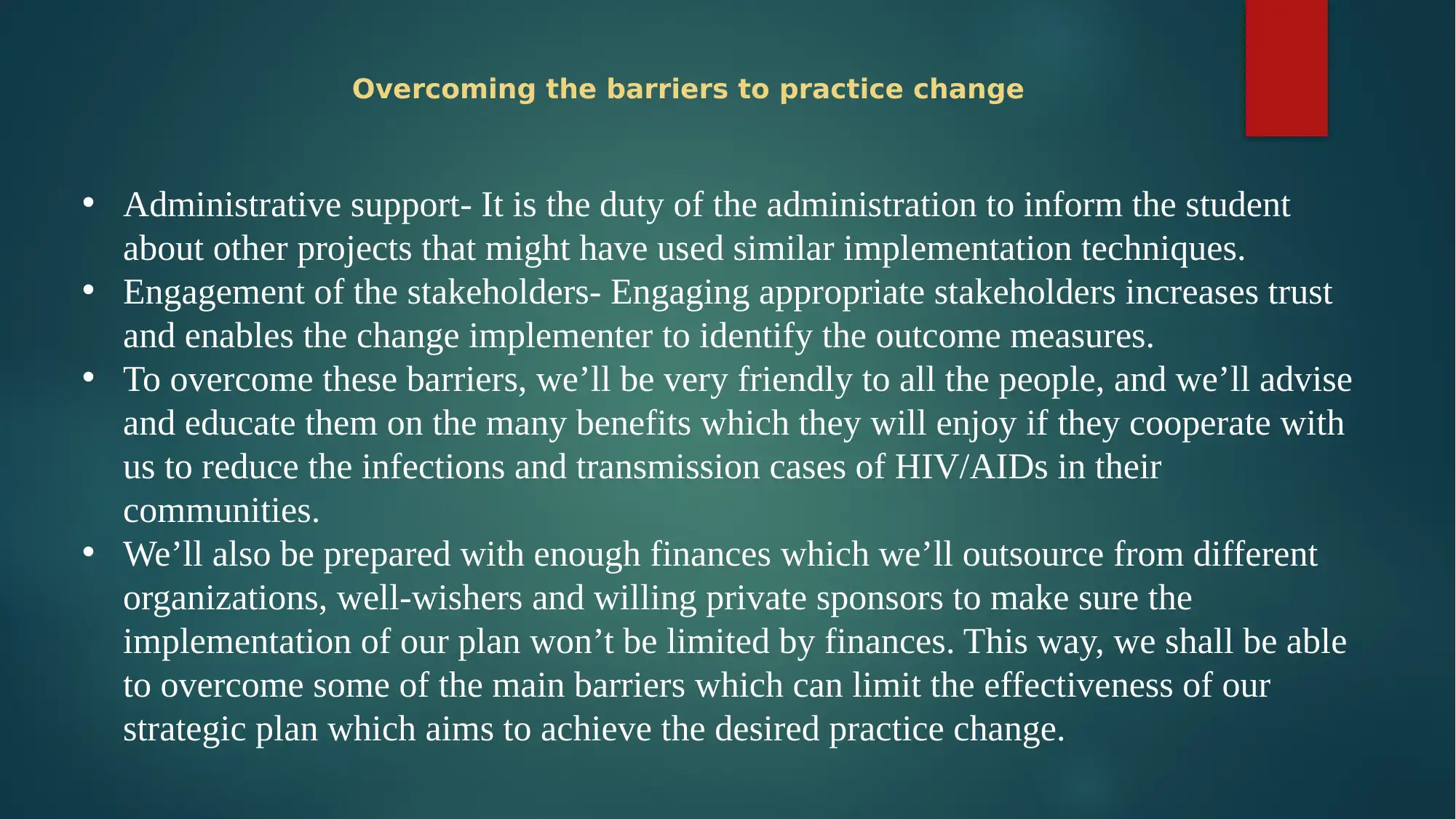
• Administrative support- It is the duty of the administration to inform the student
about other projects that might have used similar implementation techniques.
• Engagement of the stakeholders- Engaging appropriate stakeholders increases trust
and enables the change implementer to identify the outcome measures.
• To overcome these barriers, we’ll be very friendly to all the people, and we’ll advise
and educate them on the many benefits which they will enjoy if they cooperate with
us to reduce the infections and transmission cases of HIV/AIDs in their
communities.
• We’ll also be prepared with enough finances which we’ll outsource from different
organizations, well-wishers and willing private sponsors to make sure the
implementation of our plan won’t be limited by finances. This way, we shall be able
to overcome some of the main barriers which can limit the effectiveness of our
strategic plan which aims to achieve the desired practice change.
Overcoming the barriers to practice change
about other projects that might have used similar implementation techniques.
• Engagement of the stakeholders- Engaging appropriate stakeholders increases trust
and enables the change implementer to identify the outcome measures.
• To overcome these barriers, we’ll be very friendly to all the people, and we’ll advise
and educate them on the many benefits which they will enjoy if they cooperate with
us to reduce the infections and transmission cases of HIV/AIDs in their
communities.
• We’ll also be prepared with enough finances which we’ll outsource from different
organizations, well-wishers and willing private sponsors to make sure the
implementation of our plan won’t be limited by finances. This way, we shall be able
to overcome some of the main barriers which can limit the effectiveness of our
strategic plan which aims to achieve the desired practice change.
Overcoming the barriers to practice change
⊘ This is a preview!⊘
Do you want full access?
Subscribe today to unlock all pages.

Trusted by 1+ million students worldwide
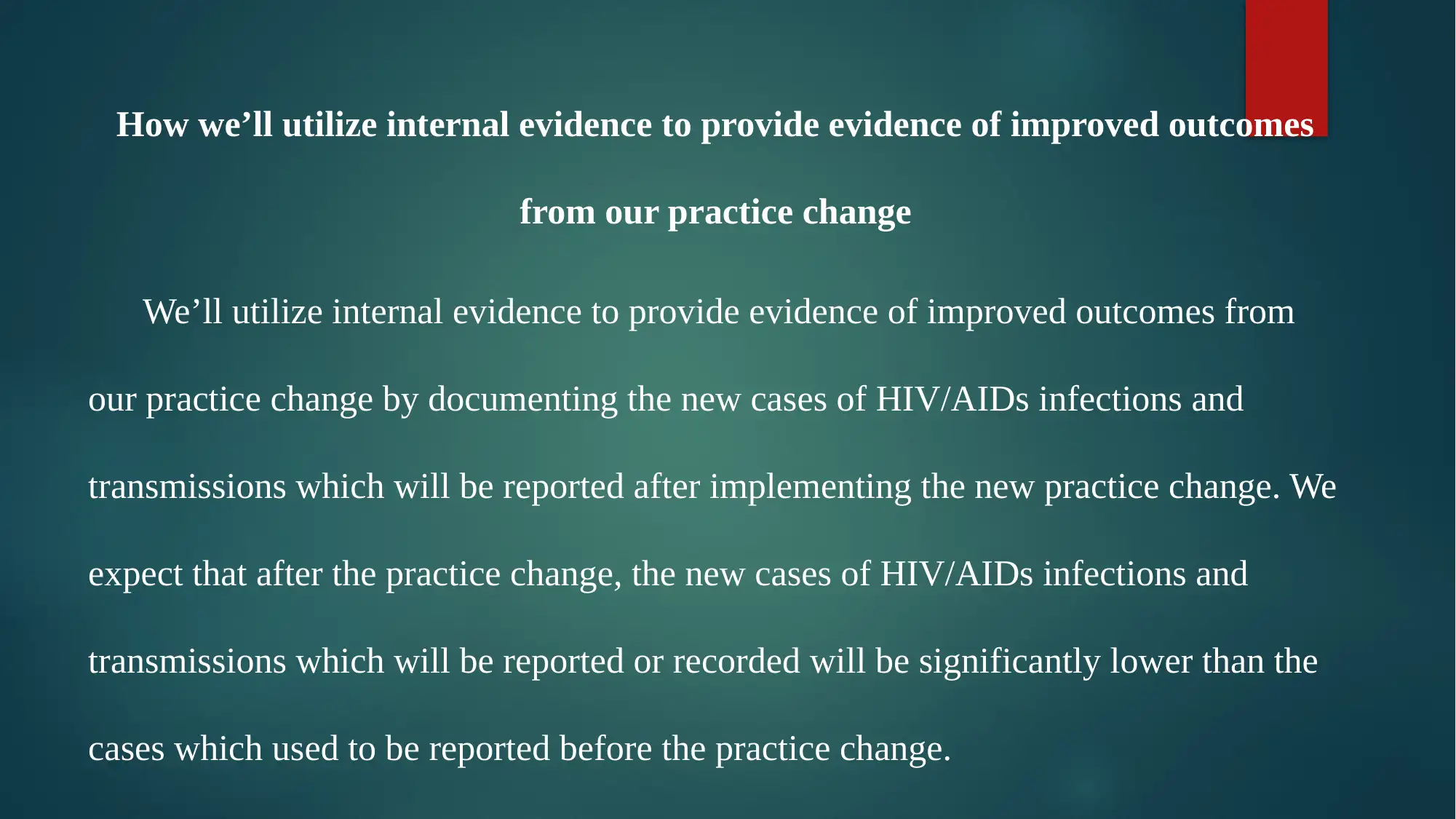
How we’ll utilize internal evidence to provide evidence of improved outcomes
from our practice change
We’ll utilize internal evidence to provide evidence of improved outcomes from
our practice change by documenting the new cases of HIV/AIDs infections and
transmissions which will be reported after implementing the new practice change. We
expect that after the practice change, the new cases of HIV/AIDs infections and
transmissions which will be reported or recorded will be significantly lower than the
cases which used to be reported before the practice change.
from our practice change
We’ll utilize internal evidence to provide evidence of improved outcomes from
our practice change by documenting the new cases of HIV/AIDs infections and
transmissions which will be reported after implementing the new practice change. We
expect that after the practice change, the new cases of HIV/AIDs infections and
transmissions which will be reported or recorded will be significantly lower than the
cases which used to be reported before the practice change.
Paraphrase This Document
Need a fresh take? Get an instant paraphrase of this document with our AI Paraphraser
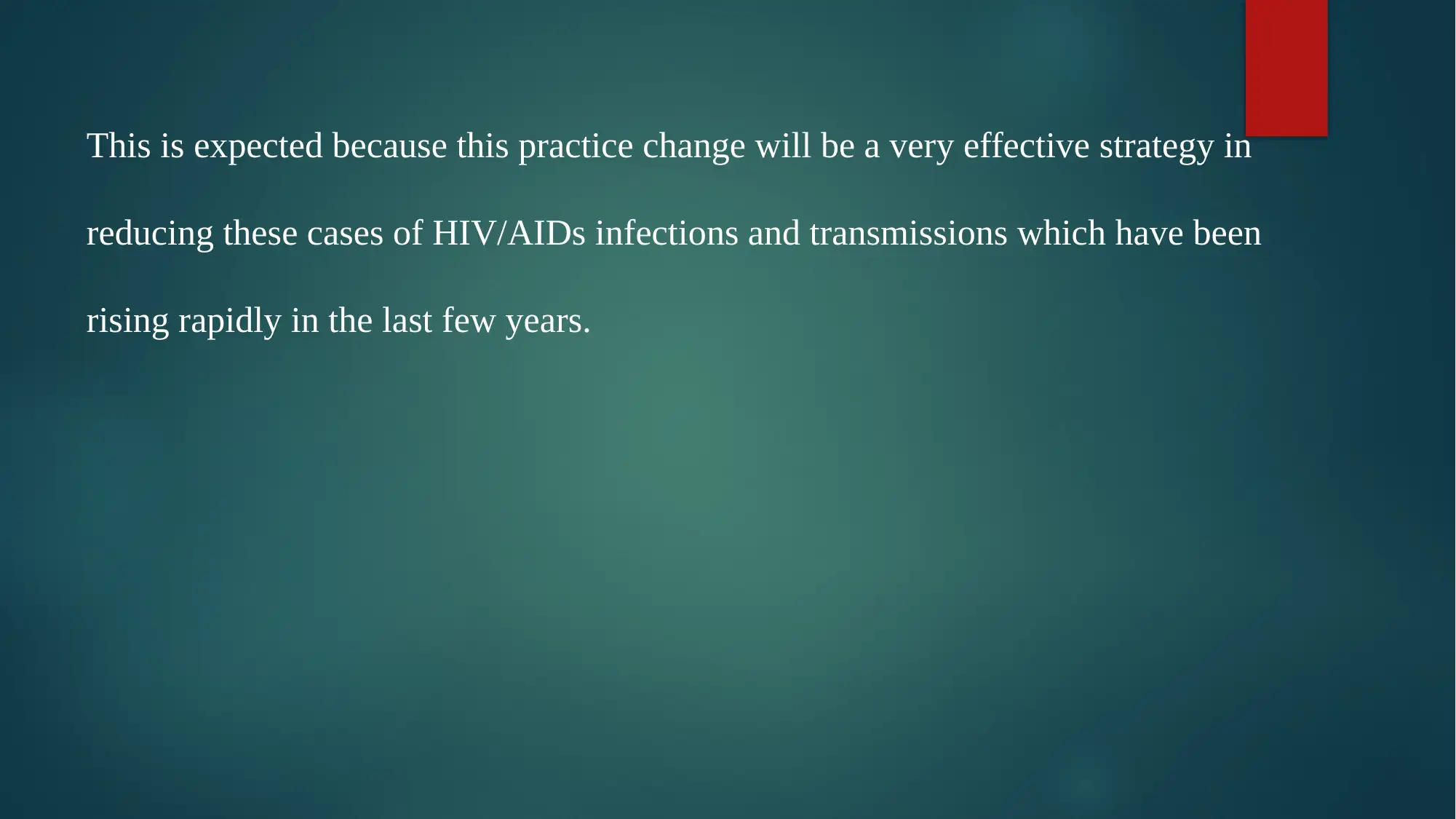
This is expected because this practice change will be a very effective strategy in
reducing these cases of HIV/AIDs infections and transmissions which have been
rising rapidly in the last few years.
reducing these cases of HIV/AIDs infections and transmissions which have been
rising rapidly in the last few years.
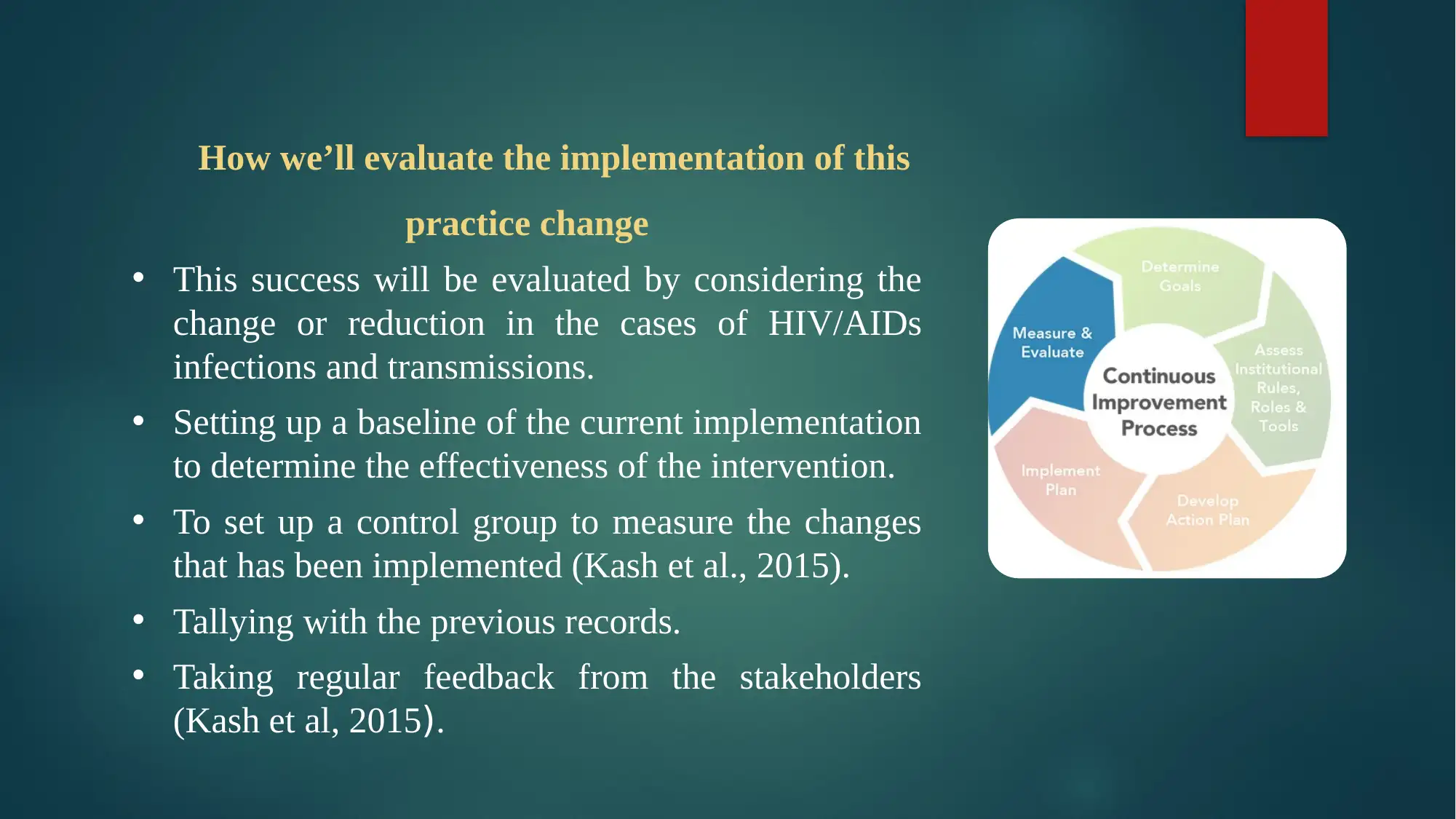
How we’ll evaluate the implementation of this
practice change
• This success will be evaluated by considering the
change or reduction in the cases of HIV/AIDs
infections and transmissions.
• Setting up a baseline of the current implementation
to determine the effectiveness of the intervention.
• To set up a control group to measure the changes
that has been implemented (Kash et al., 2015).
• Tallying with the previous records.
• Taking regular feedback from the stakeholders
(Kash et al, 2015).
practice change
• This success will be evaluated by considering the
change or reduction in the cases of HIV/AIDs
infections and transmissions.
• Setting up a baseline of the current implementation
to determine the effectiveness of the intervention.
• To set up a control group to measure the changes
that has been implemented (Kash et al., 2015).
• Tallying with the previous records.
• Taking regular feedback from the stakeholders
(Kash et al, 2015).
⊘ This is a preview!⊘
Do you want full access?
Subscribe today to unlock all pages.

Trusted by 1+ million students worldwide
1 out of 16
Related Documents
Your All-in-One AI-Powered Toolkit for Academic Success.
+13062052269
info@desklib.com
Available 24*7 on WhatsApp / Email
![[object Object]](/_next/static/media/star-bottom.7253800d.svg)
Unlock your academic potential
Copyright © 2020–2025 A2Z Services. All Rights Reserved. Developed and managed by ZUCOL.





